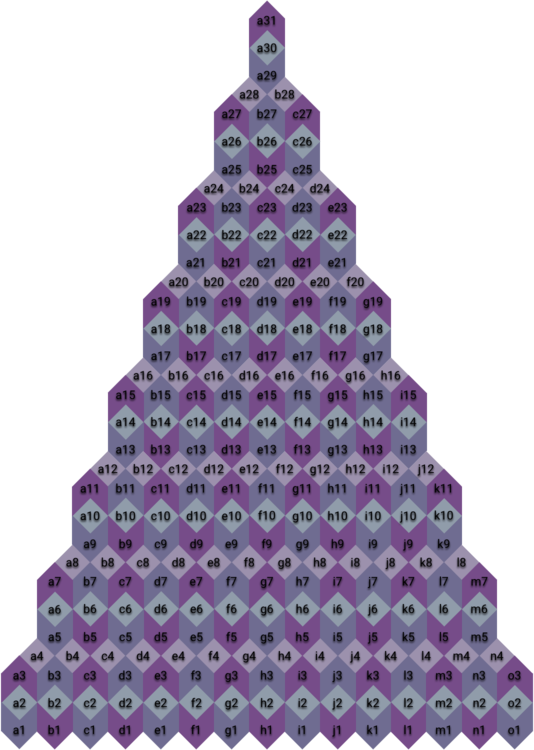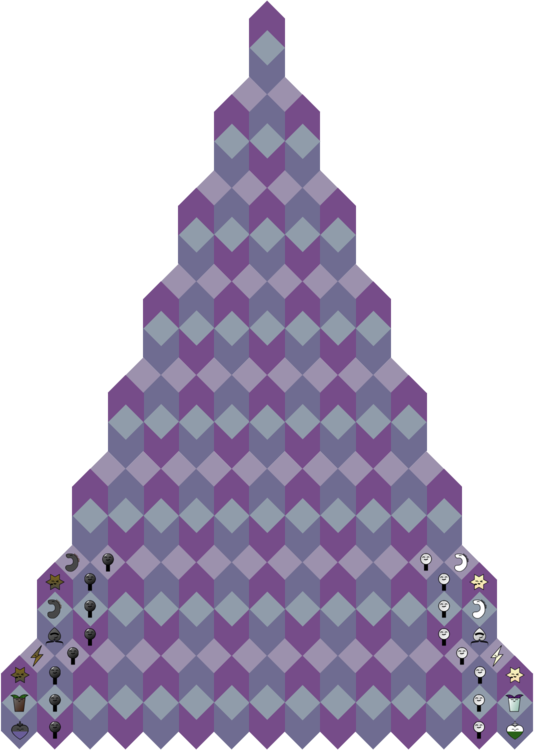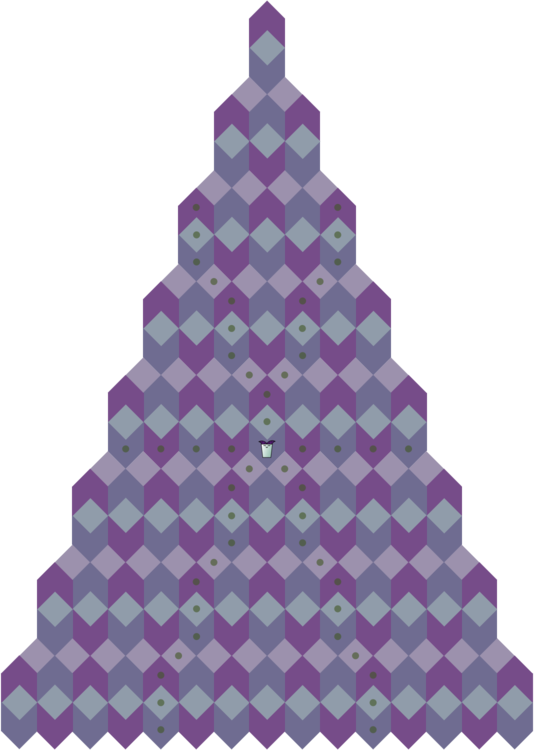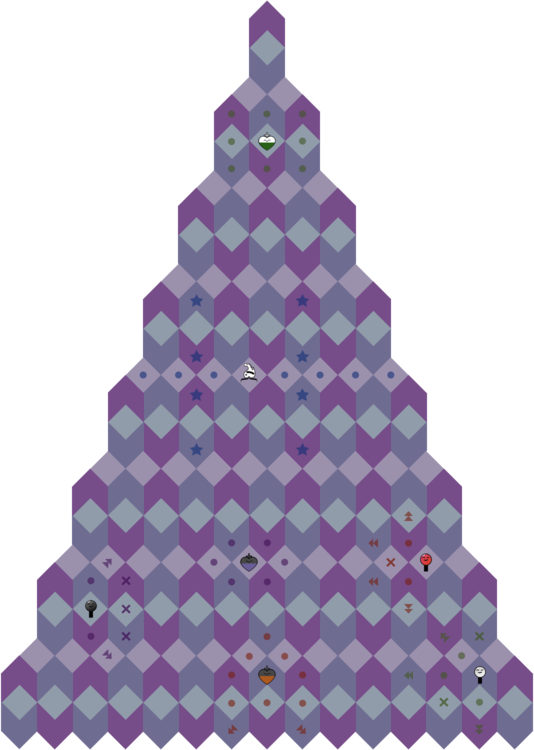Rocket Chess
I’ve never seen the games with same board. Only Max Koval’s Rhomboidal Chess and Daniil Frolov's Pentagonal Chess are near this thought, but I’ve made a game with slightly hugely different board and thematic.
Rule of cockpit is inspired by Racing Kings (game which I btw knew earlier than discovered CVP).
Board

More than half of cells is unusual. Some of them are squares, but more cells are hexagons with one non-convex angle (farther in the text called cluster cells). Therefore all squares which are inside two cluster cells and form their non-convex angle are inner squares, and squares which are placed between four cluster cells are outer squares. Cluster is a group of three cells: two cluster cells with two common angles and inner square between them.
The way coordinates work is shown below. Files are numbered from a to o and rows (ranks/diagonals) from 1 to 31.

The board has 15 files. The first file from the left has 31 space, the second has 28, the third has 27, and so on; so the fifteenth file (first from the right) has just 3 spaces. 4th, 8th, 12th, etc. ranks’ spaces are outer squares, other even ranks are inner; remaining are cluster cells.
Setup

White: K o1, R o2, S o3, Z n4, B m5, N m6, S m7, N l8; P n1-3, m4, l5-7, k8. Black: K a1, R a2, S a3, Z a4, B a5, N a6, S a7, N a8; P b1-8.
Pawns watch and move to opposite side of the board (i. e. going forward is now going to that side). White moves first.
Pieces
Each piece’s movement depends on type of cell where it stands. Most of them are classical chessmen, but some fairy and neoteric ones are also here.
Rook (R) – linear ranger
Rook (aka Chariot) is normal chess piece, and its concept hasn’t been changed since many thousand years ago. As in chess, it moves along the paths of unoccupied spaces with common borders and never changes its main directions. If this path goes to the outer square, motion continues into the next cluster which isn’t directly above/below the previous one. It has 4 directions on inner/outer squares, but it’s strongest (6 dirs, adding horizontals) on cluster cells. Rook is the strongest not promoted piece in the game.

Bishop (B) – angular rider
Bishop is normal chess piece from medieval. It moves along an endless line of free spaces with common angles: from upper/lower cluster cell to inner square of next cluster, then to lower/upper cluster cell of next cluster, and so on like a bow; its main directions don’t change. It has 4 of them on cluster cells, and it’s strongest (6 dirs, adding inner diagonals) on inner squares. Fun fact: Bishop can’t reach outer squares. It covers just 95/124 of the board, but it’s much stronger than in Chess. Here it’s closer to Shogi concept: there it’s second strongest piece which, not from start, but still can reach all the board.

Knight (N) – circular jumper
Knight (aka Horse) is normal chess piece, like the Rook, with great history and no changes behind. Its pattern is the leaping on nearest non-adjacent spaces which aren’t on the Rook’s or Bishop’s lines, ignoring anything on its way; all jumps can be described as one diagonal step with one straight (and vice-versa), but not all ways described like that lead to its destinations – it only lands on spaces with shapes different from its starting space. It has 6 directions on inner squares, 7 on cluster cells, and it’s strongest (8 dirs) on outer squares. Knight is probably the weakest substantive piece in this game, though it’s cool.

Astra (S/Å) – interstellar leaper
Astra (aka Rosetta) is neoteric piece with esoteric concept, created by me. It leaps on spaces at a distance of two Bishop’s or three Rook’s steps, also ignoring anything on its way. This is always except for outer squares where it can also move one straight and then two horizontally, or move two diagonally. It has 6 directions on inner squares, 8 on cluster cells, but it’s strongest on outer squares (10(!) dirs). Astra is the second weakest piece after Knight, but they are power together!

Zip (Z) – power switcher
Zip (aka Lightning) is neoteric piece created by me. It alters orthogonal (common borders) and diagonal (common angles) motion: it moves two like a Rook (except for from outer squares it firstly goes two horizontally) and then switches between angles and borders. Its main pattern is cluster-outer-outer-cluster, but it’s not always met: on cluster cells, it can start from outer squares; but moving two in starting cluster continues through the entire clusters in this direction (atypically for it). It has 4 directions on squares, and it’s strongest (5 dirs) on cluster cells. Unlike its bro from Horizons, Zip is mid-valued piece.


Archbishop (A) – multiplier pastor
Archbishop (aka Cardinal) is fairy piece with religious concept. It’s compound of Bishop & Knight, but also moves along outer diagonals. It has 10 directions on outer squares, 11 on cluster cells, and 12 on inner squares. The greatest number, yes?
Aanca (M/Â) – clear fair wonder
Aanca (aka Mage/Griffon) is fairy medieval piece with magic concept. It moves one space diagonally (cluster-cluster is also possible), then slides outwards as a Rook or horizontally (latter is always except for after cluster-cluster step). It has 8 directions on outer/cluster spaces & 10 on inner squares. It’s the strongest piece in the game.



Pawn (–/P/p) – popular forwarder
Pawn is normal chess piece, and again ancient. It moves one straight forward or sideways without capture, but takes/checks forward/sideways diagonally. If it can move twice in its straight direction (from outer squares also on cluster horizontals) and hasn’t yet moved, it can make double step. It’s active jogger with 2 move, 4 double step & 1 attack directions on outer squares, has 3 move/double-step and 2 (cluster-cluster diagonals are denied) attack dirs on cluster cells, and becomes toothy with 2 move/double-step and 3 attack dirs on inner squares. Pawn is the cheapest and weakest piece, it can promote.
King (K/+) – regular ruler
King (or other leader) is the piece to protect here. It moves one space in all directions, but diagonal cluster-cluster (not between clusters directly above/below) moves are possible only once per game. It has 6 directions on outer squares, 10 (8 after cluster-cluster) on cluster cells, 8 on inner squares. It can’t move to attacked spaces: King is important.

Diagrams can be quite tricky but they're still understandable.
Rules
Your aim is to checkmate opponent’s King or to race your King to the 31st rank without being checkmated: it’s said that King comes into cockpit of rocket & wins. The pieces that can checkmate are Aanca, Archbishop, Rook, Zip, Bishop, Astra+Knight. Stalemate / threefold repetition of position / 75 moves without progress (capture/promotion) are draw. There’s no castling nor en-passant.
Pawns that reach from 1st to 15th ranks on opposite side can promote to any common piece (from Knight to Rook); those who reach from 16th to 29th become Archbishop or Aanca. Promotion to King is, of course, forbidden;).
Notes
The values of pieces are Pawn = 1, Knight = 2(.25), Astra = 3, Bishop = 4, Zip = 5, Rook = 6, Archbishop = 7 and Aanca = 8.
First letter in brackets after piece's name is for computer notation, the last one is my classification.
The mainstream goal while making pieces for this game was to avoid repetitions of moves, which partially failed (2nd Bishop's step as 3rd Rook's, and Zip copying 4 of 8 Knight's dests on outer cells), but in general is successfully done.
The funniest fact that there are only four types of pieces (excluding Pawn which can become one of them) that can normally use the cockpit space: Astra, Zip, Rook and, logically, King.
Aanca can reach whole the board and two cockpit spaces too, but it becomes immobile after this; Knight (and consequently Archbishop) can normally use the previous-to-last inner square; and Bishop can't reach both of them – maximally the remaining third cell of this important cluster.
You can always search hidden esoteric senses and find my musical track inspired by this game.
link to track / link to track and video with making this variant's board
 This 'user submitted' page is a collaboration between the posting user and the Chess Variant Pages. Registered contributors to the Chess Variant Pages have the ability to post their own works, subject to review and editing by the Chess Variant Pages Editorial Staff.
This 'user submitted' page is a collaboration between the posting user and the Chess Variant Pages. Registered contributors to the Chess Variant Pages have the ability to post their own works, subject to review and editing by the Chess Variant Pages Editorial Staff.
By Lev Grigoriev.
Last revised by Lev Grigoriev.
Web page created: 2023-10-10. Web page last updated: 2023-10-10